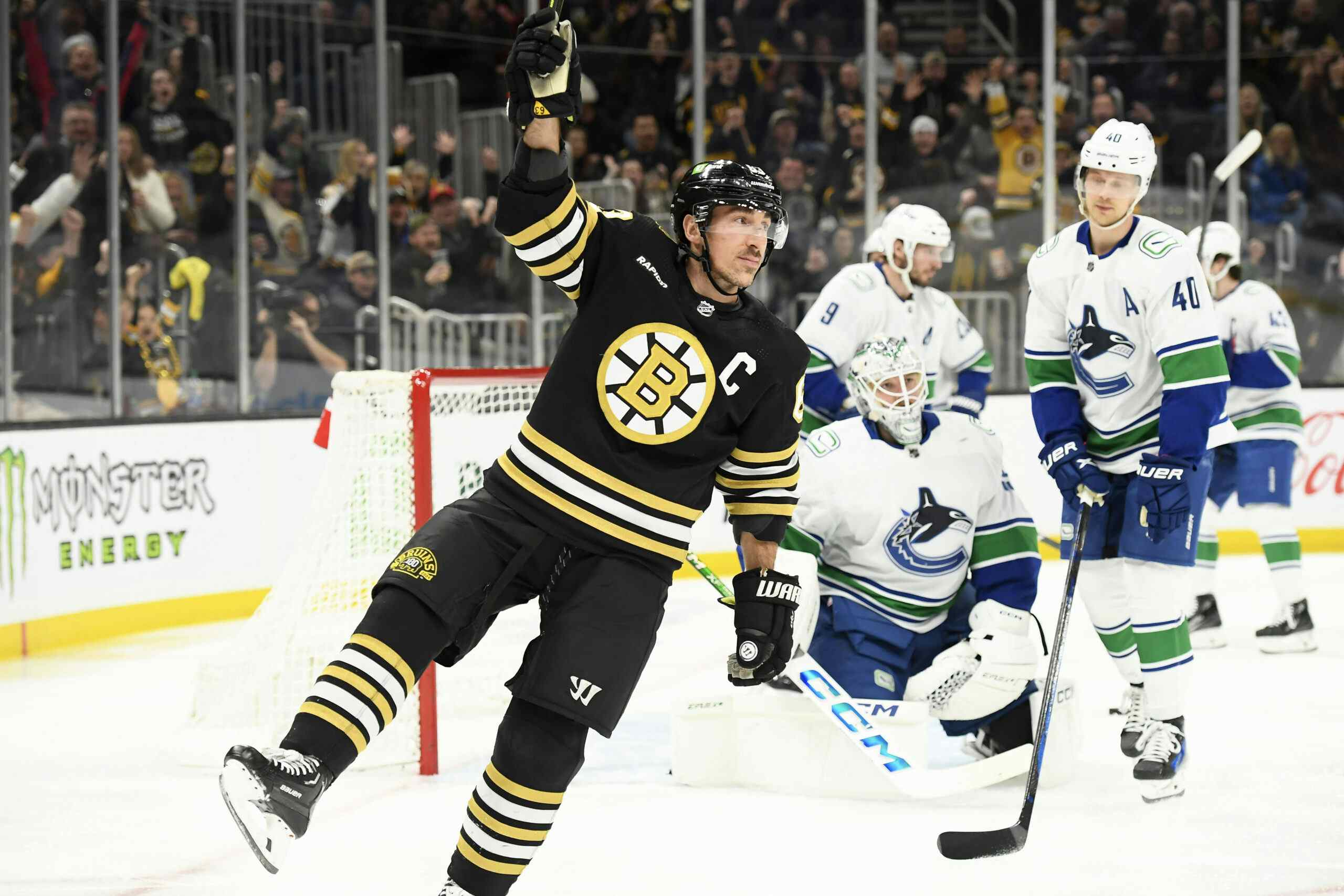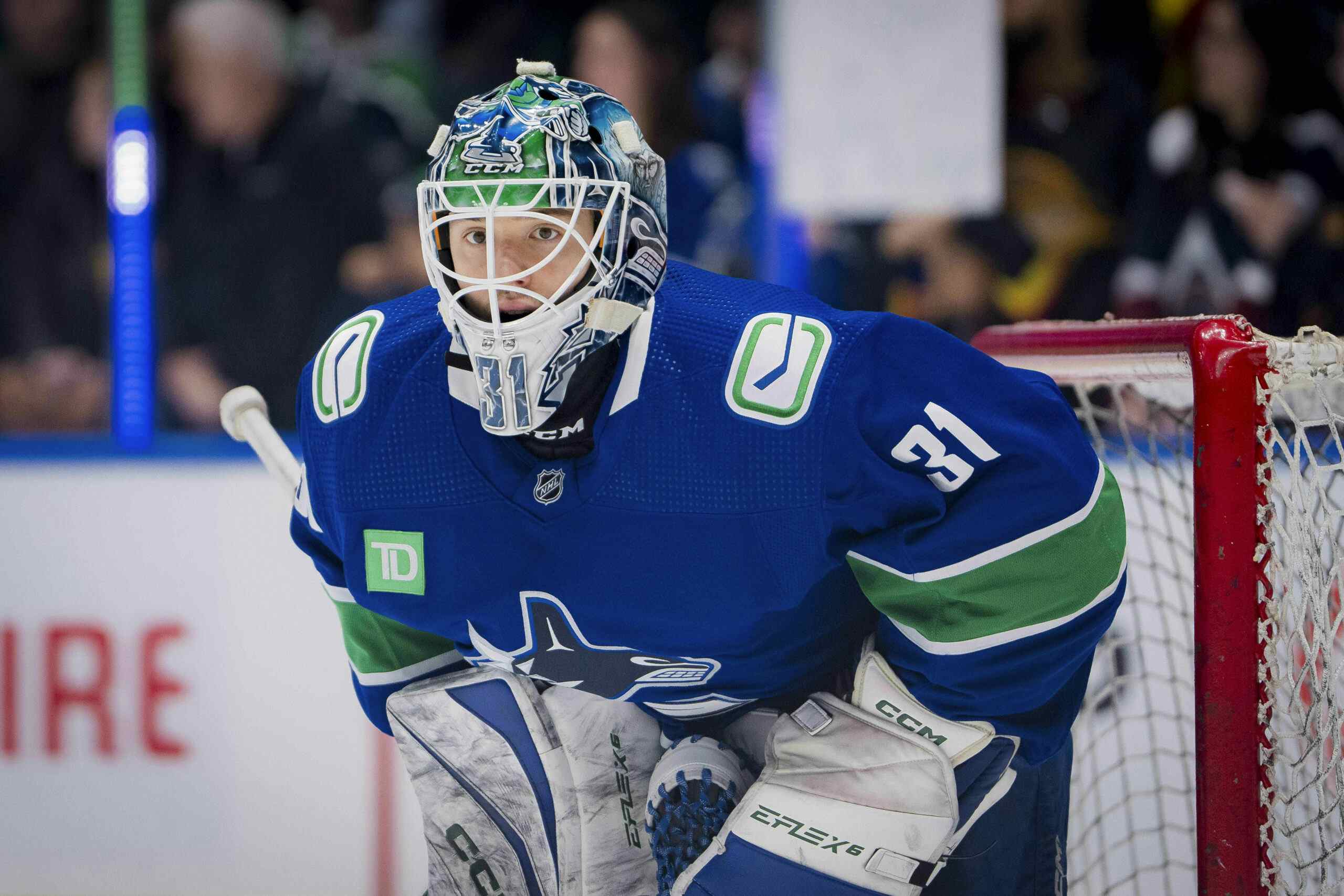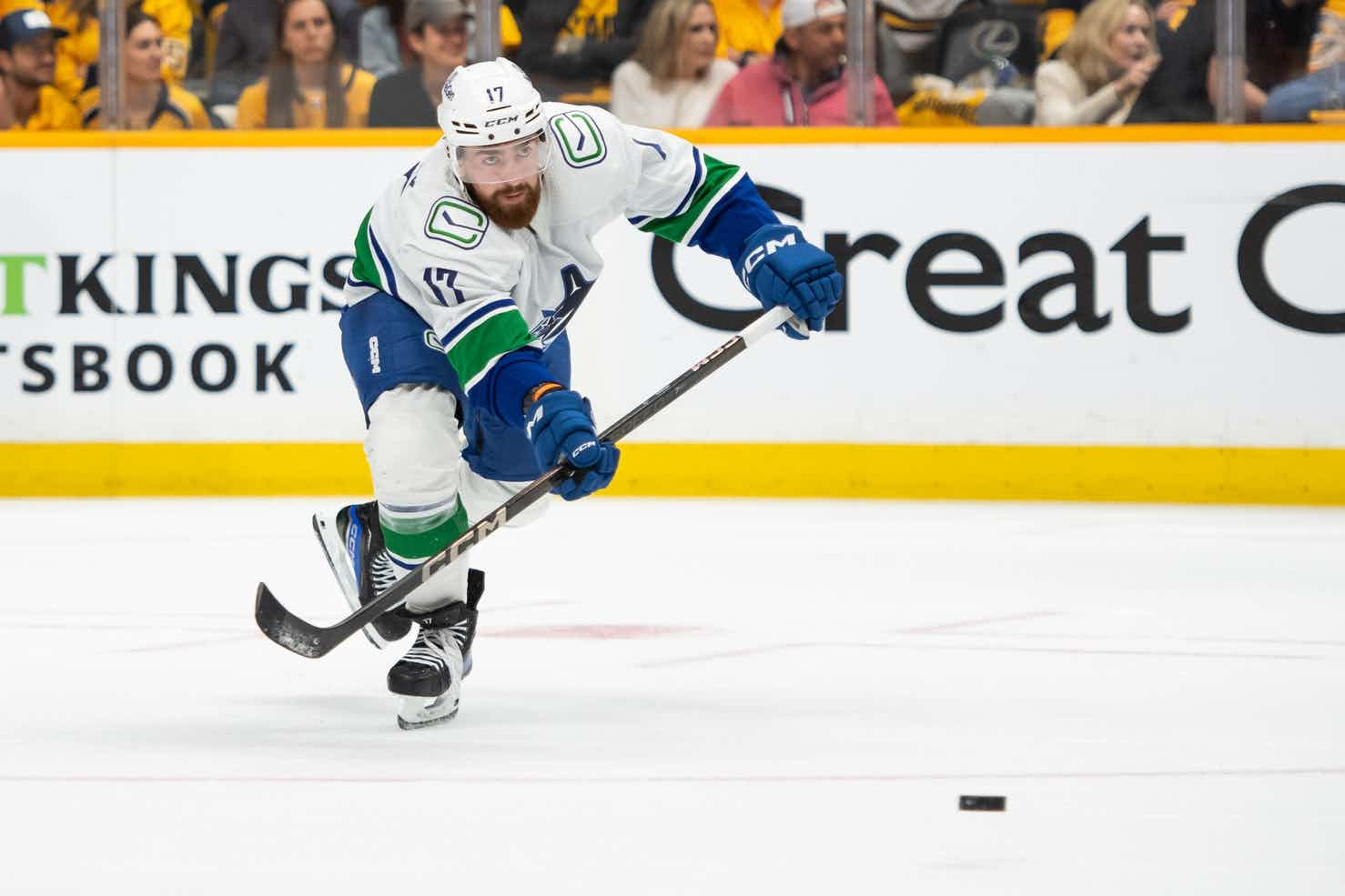2018 NHL Draft Preliminary Rankings: 11 to 15

By Jeremy Davis
6 years agoAfter covering the top ten of the 2018 NHL Entry Draft, today I’m running through the prospects I’ve ranked 11th to 15th. The younger brother theme still has a little more to give, and there are more high end defencemen to be had, although these are a bit more of the two-way variety than the flashy puck rushing types.
If you missed the first two articles, you can find them here:
The remainder of my top 50 list should be coming out shortly. Until then, enjoy this deep dive into five prospects that could comprise a section in the early-mid first next June.
A Rundown of the Stats Used In These Articles
If you’ve already read this in the previous articles, you can go ahead and skip this section.
You can get draft lists from a myriad of sources, but since you came to Canucks Army, you can expect somewhat of a statistical lean. There will be video and some scouting reports as well, but much ink will be spilt on stats, as we have metrics here that you won’t find anywhere else. What follows is a brief description of each of the stats referenced in the tables below.
- Age: Exact age to two decimal points, calculated as of September 15th, 2016. That date is used for draft purposes – anyone with an exact age greater than or equal to 16.00 and less than 17.00 as of that date will be eligible for the first time in the 2018 draft.
- Box Cars: GP, G, A, P stand for the standard Games Played, Goals, Assists, and Points, during the 2016-17 regular season.
- Sh/GP: Shots on goal per games played.
- GF%: Percentage of 5-on-5 on-ice goals scored in favour of the player’s team.
- GF%rel: The difference between the player’s on-ice GF% relative to the team’s GF% when the player is off the ice.
- pGPS:
- xSucc is Expected Success Rate for the player, based on how many similar players reached a 200 NHL game threshold, weighted by similarity.
- xPro/82 is the Expected Production of the player per 82 games, based on how similar players produced in the NHL, weighted by similarity.
- xVal is Expected Value, the product of xSucc and xPro/82. Check this article to see an Expected Value curve from last year’s draft to get an idea of what constitutes a “good” xVal. Last year the expected values in the first round ranged from about 35 to 15.
- SEAL: The SEAL adjusted scoring value. SEAL stands for Situational, Era, Age, and League. Here’s a rundown of the current iteration of SEAL, which evolved from a technique that Garret Hohl pioneered for the 2015 draft.
Certain metrics are only available for certain leagues, depending on how easily available the data is to the public, and in some cases whether or not Dylan Kirkby (our resident programmer) and I have had the time to set up the necessary data scrapers. Here’s a run down on which metrics are available in which leagues.
- pGPS: I can run pGPS data on about 20 leagues right now, so at the top of the draft, it’s easier just to say which leagues it doesn’t do. For the purposes of this list, the missing leagues are: the MHL (Russian Junior), SM-Liiga Nuorten (Finnish Junior).
- SEAL: SEAL adjustments are currently available for all CHL leagues (WHL, OHL, QMJHL), USHL, NCAA, SHL, and Czech Extraliga. Dependent on availability of situational scoring data.
- GF% and GF%rel: Currently available for all CHL leagues (WHL, OHL, QMJHL), USHL, SHL, and Czech Extraliga.
#11 – Jared McIsaac (D – QMJHL)
| Age | Height | Nat. | Season | League | GP | G | A | P | Sh/GP | GF% | GF%rel | pGPS xSucc | xPro/ 82 | pGPS xVal | SEAL |
| 16.47 | 6.02 | CAN | 2016-17 | QMJHL | 59 | 4 | 28 | 32 | 1.83 | 60.0% | +12.7% | 35% | 26 | 9.0 | 0.484 |
Jared McIsaac is a big, strong, two-way defender that excels at directing the flow of play He has a combination of speed and strength that makes his very tough for opponents to contain, as he retrieves the puck from his own end and transitions it quickly up the ice, either by long crisp passes or by quick, powerful rushes. In either case, McIsaac quickly takes the puck from dangerous areas to offensive opportunities.
Possessing a strong point shot, McIsaac probably deserved more than the four goals that he scored for the Halifax Mooseheads in 2016-17, operating with a 3.7% shooting percentage. Three of his goals came on the power play, leaving plenty of room for offensive improvement in 2017-18.
Failed to load video.
pGPS has pegged McIsaac with a 35% Expected Success Rate, with his cohort averaging second pairing production. That cohort includes names like Patrice Brisebois, Francois Beauchemin, and Marc-Edouard Vlasic.
Playing on the Mooseheads with Nico Hischier, the eventual first overall pick in the 2017 NHL draft, one might assume that McIsaac’s point totals benefited directly from sharing the ice with the Swiss phenom. As it turns out, according to these numbers, both Hischier and linemate Maxime Fortier (one of the QMJHL’s top scorers) saw their rate production drop when away from McIsaac, which is a tremendous sign.
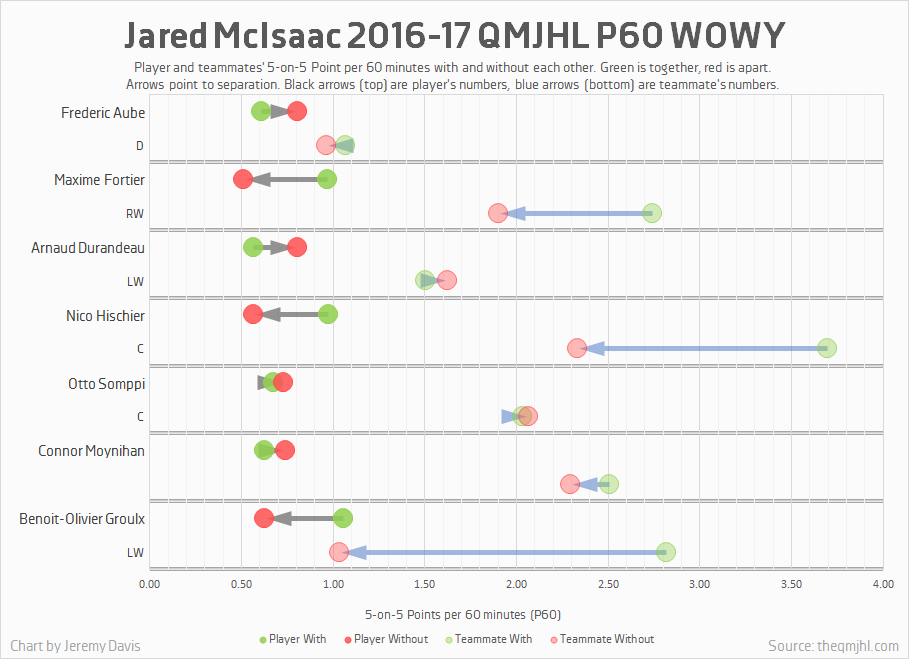
McIsaac’s on-ice numbers were stellar, with the Mooseheads accounting for 60% of the goals scored when he was on the ice. The Mooseheads were a net negative team at even strength, giving McIsaac a GF%rel of +12.7%, the third best relative rate of any draft-minus-one player that I could generate numbers for.
Last season, McIsaac had the good fortune of sharing plenty of ice with Nico Hischier. While Hischier is virtually a lock to start the season in New Jersey, McIsaac will again benefit from playing with a high end forward prospect, as Filip Zadina, ranked number five on this list, will join him in Halifax next season.
#12 – Ryan McLeod (C – OHL)
| Age | Height | Nat. | Season | League | GP | G | A | P | Sh/GP | GF% | GF%rel | pGPS xSucc | xPro/ 82 | pGPS xVal | SEAL |
| 16.99 | 6.02 | CAN | 2016-17 | OHL | 68 | 9 | 33 | 42 | 1.63 | 57.5% | +4.7% | 21% | 38 | 7.8 | 0.772 |
We come to yet another younger brother, and this time it’s Ryan McLeod, younger brother of New Jersey 2016 first round pick Michael McLeod in this same 12th spot. Ryan, who just missed the cutoff for the 2017 draft, just completed his second season as a member of the Mississauga Steelheads, where his brother also plays. At this point, Ryan is trending to be a more productive player that Michael is, outscoring Michael’s respective draft-minus-one season by 13 points.
Ryan doesn’t have the same straightaway speed that Michael is known for, but his skating is still quite good, and boosted by excellent side-to-side maneuvering and agility. A pass first player, Ryan fits the mold of the puck-distributing centre, and his on-ice vision and high end passing ability serve to improve the production of his wingers. The on-ice numbers appear to back this up, as the estimated points per 60 minutes of Michael McLeod, Spencer Watson, Nathan Bastian, Brendan Harrogate, and Trent Fox all decreased when separated from Ryan.
Failed to load video.
McLeod’s on-ice presence had a positive effect on his team’s goal differential as well, as he posted a 57% goals-for percentage, and a +4.7 GF%rel. Scouts have noted that his play away from the puck could still use some improvement, but his ability to maintain possession and keep the puck in the offensive end is at least helping keep his team’s goal differential in the black.
McLeod’s individual production is decent, but it isn’t near the top of the list for draft-minus-one players, at least not when SEAL adjustments are applied. His adjusted point rate of 0.77 is pretty similar to his raw point rate. Born just after the cutoff, he doesn’t gain any age benefits, and his situational scoring is balanced in such a way that it doesn’t hurt him, but it doesn’t help him either.
Dave Andreychuk, Mike Fisher, Matt Stajan and Jeff Carter make appearances on his list of statistical matches, with the pGPS formula giving him a 21% Expected Success Rate.
#13 – Akil Thomas (C – OHL)
| Age | Height | Nat. | Season | League | GP | G | A | P | Sh/GP | GF% | GF%rel | pGPS xSucc | xPro/ 82 | pGPS xVal | SEAL |
| 16.70 | 5.11 | USA | 2016-17 | OHL | 61 | 21 | 27 | 48 | 2.39 | 40.5% | -7.4% | 29% | 50 | 14.8 | 0.981 |
Akil Thomas is a fascinating player. He has been described as a game-breaking talent; he possesses highly impressive top speed, a deadly shot, and strong hockey sense. Thomas makes intelligent plays and can beat defenders one-on-one while also rarely getting himself into trouble. He scored 20 goals this season for a poor team in Niagara and made the Under-18 team as an underager in April.
Failed to load video.
There’s a flipside, though. Thomas is lacking in both size and strength and is often out-muscled as a result. Moreover, his attention to detail in his zone is subpar, as he prefers to hover looking for breakout passes rather than help out his teammates down low. As a result, he has some abysmal on-ice statistics despite excellent offensive numbers. Thomas provides an interesting case study from a statistical view, and is a prime example of why more than one metric is often needed when assessing players.
From an offensive perspective, Thomas is a star player at his level. His SEAL adjusted scoring rate of 0.98 was the fourth highest among our draft-minus-one sample, and his 17 5-on-5 goals were third highest. Nearly a third of his statistical comparables went on to carve out NHL careers, with names like Owen Nolan, Andrew Cassels, Dave Gagner, and Michael Peca among them.
From a two-way perspective, however, there are some bright red flags, starting with the fluctuations between his on- and off-ice numbers. In the with-or-without-you chart below, you’ll see a uniform line of red bubbles along the top, indicating that each one of Thomas’ seven most frequent linemates performed better concerning goal differential when they were away from him. That is a concern.
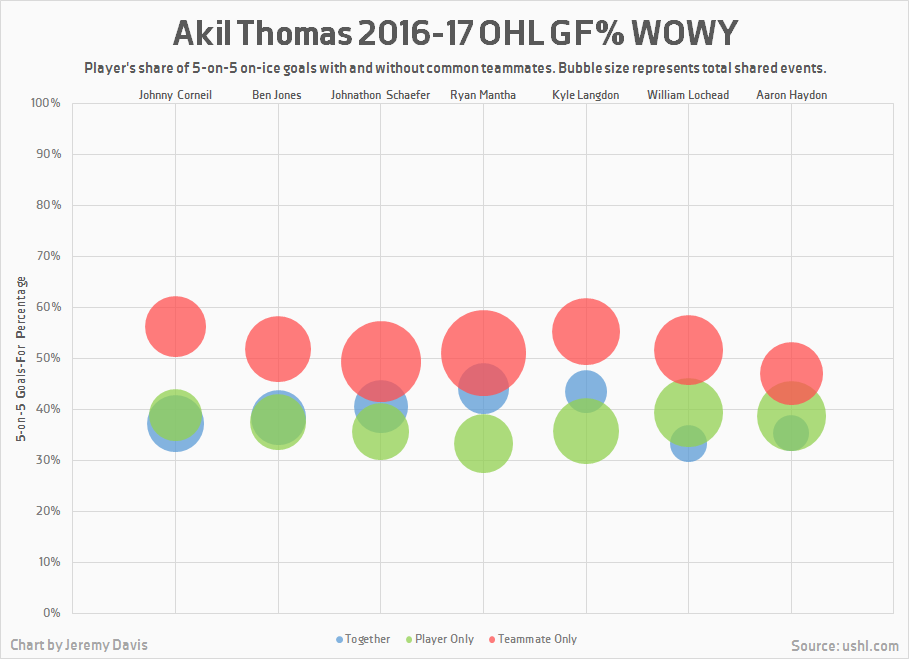
In order to paint a more definitive picture of Thomas’ abilities, he’ll need to be given more time to see if he can adjust his in-game consistency and effort level across all 200 feet of the ice sheet. The 200-foot player is an oft-overrated fetish in modern hockey, but at its core, the game is about outscoring the opponent. Much like our criticism of Brandon Sutter, it doesn’t matter much if the player can pot 20 goals if the other team is consistently outscoring them when the player is on the ice. Bulking up will help Thomas plenty, but his dedication to getting pucks out of his zone will also be a decisive factor in his eventual fate as a hockey player.
#14 – Evan Bouchard (D – OHL)
| Age | Height | Nat. | Season | League | GP | G | A | P | Sh/GP | GF% | GF%rel | pGPS xSucc | xPro/ 82 | pGPS xVal | SEAL |
| 16.91 | 6.02 | CAN | 2016-17 | OHL | 68 | 11 | 33 | 44 | 1.99 | 58.7% | -4.3% | 41% | 37 | 15.3 | 0.694 |
If you’re a Canucks fan and you followed along with Olli Juolevi’s 2016-17 campaign in London, you’ve probably heard that one of the potential reasons that his scoring plateaued is that he was tasked with bringing along a 16-year old defensive partner – well, this is that player.
Evan Bouchard is a smart and responsible defenceman with good offensive instincts. He’s known to rush the puck when the opportunity presents itself, and though his top speed is decent, his acceleration is somewhat poor. He isn’t overly flashy, but he can make high skilled plays. He has a hard point shot and a knack for maneuvering himself into a position to get it through to the net.
Failed to load video.
Defensively he utilizes his size well (6-foot-2, 190 pounds) to play opponents physically, box out the net front, and lay his share of punishing body checks. His suspect footwork, however, can lead to struggles in one-on-one battles against agile forwards.
Bouchard’s SEAL adjusted scoring rate of 0.69 was the third highest among defencemen in the sample, and he had the second most five-on-five points. No doubt he benefited to some degree by playing for the London Knights — still one of the OHL’s best teams — but his offensive rate production stayed fairly consistent whether he was on the ice with London’s first or fourth line, and his on-ice numbers fluctuated very little, hovering close to 60% regardless of who he shared the ice with. His shot rate of 1.99 shots on net per game trailed only Ryan Merkley (ranked 4th) among draft-minus-one prospects in the CHL.
It’s likely that Bouchard’s role with the Knights will expand exponentially in the coming season as their defence corps are in a state of transition. It’s uncertain where Canucks prospect Olli Juolevi will land next year (both the NHL and the Finnish Liiga are still possibilities), while New York Islanders prospect Mitch Vande Sompel, Dallas prospect Chris Martenet and New York Rangers prospect Brandon Crawley are likely to move on to pro hockey.
#15 – Joel Farabee (LW – USHL)
| Age | Height | Nat. | Season | League | GP | G | A | P | Sh/GP | GF% | GF%rel | pGPS xSucc | xPro/ 82 | pGPS xVal | SEAL |
| 16.56 | 5.11 | USA | 2016-17 | USHL | 28 | 12 | 11 | 23 | 1.73 | 54.5% | +11.0% | 0% | 35 | 0.0 | 0.894 |
Joel Farabee is another US National Team Development Program player who has impressed both in domestic and international play. As an underager at last year’s World Under-18 tournament, the speedy winger put up six points in seven games. Farabee plays the game with a whole lot of pace, and has the ability to make intelligent plays at high speeds. His shot doesn’t have a ton of kick to it at this point, but he gets it off quickly. Farabee rarely stops moving, an asset which can pull opponents out of position and create openings for teammates.
Failed to load video.
Farabee’s SEAL adjusted scoring rate of 0.89 represents a sizable increase over his unadjusted point rate, especially given that he comes from the USHL. Much of this increase comes from situational adjustments, as Farabee’s 11 even strength goals gave him one of the USHL’s highest per game rates in 5-on-5 goal scoring. His 5-on-5 primary assist rate was also impressive.

pGPS assigned Farabee a very uninspiring score of zero percent, which sounds a bit ominous, but USHL players are always in a uphill battle in cohort models, considering that the league has come so far in recent years. I wouldn’t read into that too deeply, and we’ll see how that fluctuates in his draft year.
From an on-ice perspective, Farabee is in the same boat as Brady Tkachuk and Quinton Hughes from the last article, in that as a member of the U18 USNTDP team, his team relative stats get a huge boost because they share a USHL schedule with the U17 team, which often fairs much worse. But again, as with his U18 teammates, having an on-ice goal share above 50% is still a good thing.
Recent articles from Jeremy Davis



